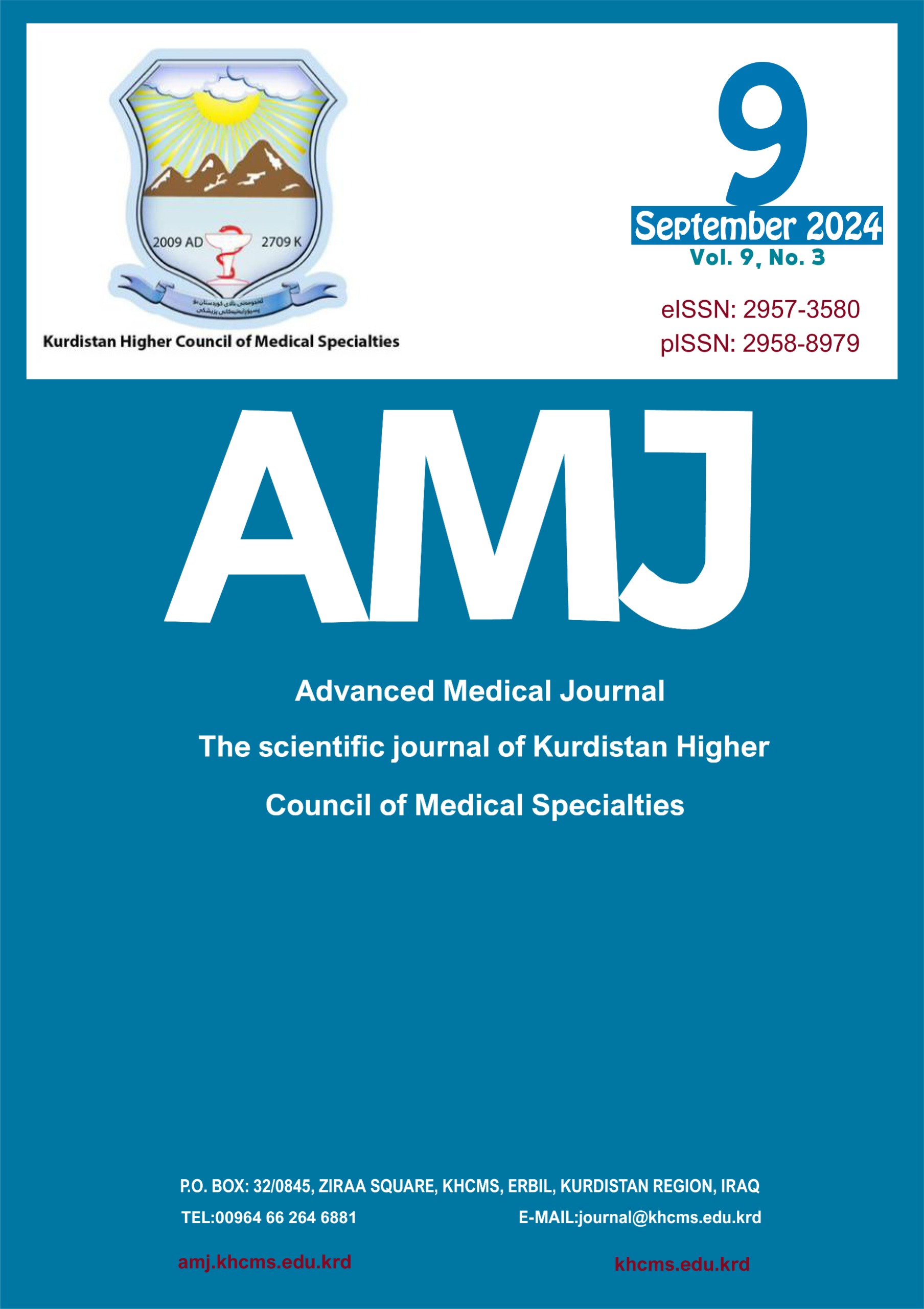Minimal Residual Disease in Pediatric Acute Lymphoblastic Leukemia
DOI:
https://doi.org/10.56056/amj.2024.283Keywords:
Acute Lymphoblastic Leukemia, Flow Cytometry, Minimal Residual Disease, MorphologyAbstract
Background and ObjectiveThe detection of minimal residual disease at the end of initial therapy in Acute Lymphoblastic Leukemia to assess risk stratification is gaining clinical significance. While minimal residual disease assesses the extent of remission, remission is still defined by bone marrow morphology. The aim of this study is to determine the significance of minimal residual disease.
Methods: In this cross-sectional study conducted at Zheen Oncology Center and Azadi hospital in Duhok, Iraq, data was collected from 46 patients’ records. Residual disease was detected by flow cytometry. On day 29 of induction therapy, a bone marrow sample was obtained for morphology and flow cytometry. The presence or absence of MRD was determined by using 8-color flow cytometry.
Results: The median age of the study was 7 years and the male to female ratio was 1.7:1. B-cell lymphoblastic leukemia accounted for 80.43% and T-cell was 19.57%. Bloodounts at diagnosis revealed a mean white blood cell count of 74.32 x /L, mean hemoglobin level of 8.75, g/dL, and a mean platelet count of 97.84 x L. Minimal residual diease positive results were seen in 29 cases; 21 cases were of B-cell leukemia (56.75) and 8 (88.88) cases were T-cell leukemia. Minimal residual disease negative results were achieved in 17 cases; 43.24% were of B-cell origin (p value <0.001), 11.11% were of T-cell origin (p value 0.008). Remission was achieved in 81.08 cases of B-cell (p value 0.103), and 66.66 of T-cell (p value 0.403). 16.21% of B-cell leukemia passed away (p value <0.001) and 33.33% of T-cell leukemia (p value 0.065).
Conclusion: Flow cytometry should be done in addition to bone marrow morphology.
Downloads
References
Cazzaniga G, Valsecchi M, Gaipa G, Conter V, Biondi A. Defining the correct role of minimal residual disease tests in the management of acute lymphoblastic leukaemia. Br J Hematology. 2011; 155(1):45-52.
Kim I. Minimal residual disease in acute lymphoblastic leukemia: technical aspects and implications for clinical interpretation. Blood Res. 2020;55(S1):S19-S26.
Coustan-Smith E, Mullighan CG, Onciu M, Behm F, Raimondi S, Pei D et al. Early T-cell precursor leukaemia: a subtype of very high-risk acute lymphoblastic leukaemia. Lancet Oncol. 2009. 10(2):147-56.
McKenna RW, LaBaron WT, Aquino DB, Picker LJ, Kroft SH. Immunophenotypic analysis of hematogones (B-lymphocyte precursors) in 662 consecutive bone marrow specimens by 4-color flow cytometry. Blood. 2001. ;98(8):2498-507.
Campana D, Pui CH. Minimal residual disease-guided therapy in childhood acute lymphoblastic leukemia. Blood. 2017; 129(14): 1913–8.
van Dongen JJ, van der Velden VH, Brüggemann M, Orfao A. Minimal residual disease diagnostics in acute lymphoblastic leukemia: need for sensitive, fast, and standardized technologies. Blood. 2015. 125(26):3996-4009.
Roshal M, Fromm JR, Winter SS, Dunsmore KP, Wood BL. Immaturity associated antigens are lost during induction for T cell lymphoblastic leukemia: implications for minimal residual disease detection. Cytometry B Clin Cytom. 2010;78(3):139-46.
Farahat N, Morilla A, Catovsky D, Ricardo Morilla Pinkerton C et al. Detection of minimal residual disease in B-lineage acute lymphoblastic leukaemia by quantitative flow cytometry Br J Haematol. 1998;101(1):158-64.
Jalal SD, Al-Allawi NA, Al Doski AA. Immunophenotypic aberrancies in acute lymphoblastic leukemia from 282 iraqi Patients. Int J Lab Hematol. 2017;39(6):625-32.
Dworzak MN, Fritsch G, Fleischer C, Printz D, Fröschl G, Buchingeret Pal. Multiparameter phenotype mapping of normal and post-chemotherapy B lymphopoiesis in pediatric bone marrow. Leukemia. 1997; 11(8):1266-73.
Dworzak MN, Gaipa G, Schumich A, Maglia O, Ratei R, Veltroni M et al. Modulation of antigen expression in B-cell precursor acute lymphoblastic leukemia during induction therapy is partly transient: evidence for a drug-induced regulatory phenomenon. Results of the AIEOP-BFM-ALL-FLOW-MRD-Study Group. Cytometry B Clin Cytom. 2010;78(3):147-53.
Rhein P, Scheid S, Ratei R, Hagemeier C, Seeger K, Kirschner-SchwabeGene R et al. expression shift towards normal B cells, decreased proliferative capacity and distinct surface receptors characterize leukemic blasts persisting during induction therapy in childhood acute lymphoblastic leukemia. Leukemia, 2021; 21: 897–905.
Rathe M, Preiss B, Marquart HV, Schmiegelow K, Wehner PS. Minimal residual disease monitoring cannot fully replace bone marrow morphology in assessing disease status in pediatric acute lymphoblastic APMIS. 2020; 128(5):414-9.
Yokota S., Hansen-Hagge TE, Ludwig WD, ReiterA, RaghavacharmA, Kleihauer E, et al. Use of polymerase chain reactions to monitor minimal residual disease in acute lymphoblastic leukemia patients. Blood. 1991; 77(2):331-9.
Osterweil N. MRD better measure of ALL remission than morphology. 2017. Available from: https://www.mdedge.com/pediatrics/article/137626/all/mrd-better-measure-all-remission-morphology/
Ayyanar P, Kar R, Dubashi B, Basu D, Post-chemotherapy Changes in Bone Marrow in Acute Leukemia with Emphasis on Detection of Residual Disease by Immunohistochemistry, Cureus 13(12): e20175. DOI: 10.7759/cureus.20175/
Vora A, Goulden N, Mitchell C, Hancock J, Hough R, Rowntreeet C et al. Augmented post-remission therapy for a minimal residual disease-defined high-risk subgroup of children and young people with clinical standard-risk and intermediate-risk acute lymphoblastic leukaemia : a randomised controlled trial. Lancet Oncol. 2014;15(8):809-18.
Gupta S, Devidas M, Loh ML, Raetz E, Chen S, Wanget C et al. Flow cytometric vs morphologic assessment of remission in childhood acute lymphoblastic leukemia: A report from the Children’s Oncology Group (COG), Leukemia. 2018;32(6):1370-1379.
Karawajew L, Dworzak M, Ratei R, Gaipa G, Buldiniet B, Basso G et al. Minimal residual disease analysis by eight-color flow cytometry in relapsed childhood acute lymphoblastic leukemia. Haematologica. 2015;100(7):935-44.
O'Connor D, Moorman AV, Wade R, Hancock J, Tan R, Bartram J et al. Use of minimal residual disease assessment to redefine induction failure in pediatric acute lymphoblastic leukemia. J Clin Oncol. 2017;35(6):660-7.
Schrappe M, Valsecchi MG, Bartram CR, Schrauder A, Panzer-Grümayer R, MörickeetA et al. Late MRD response determines relapse risk overall and in subsets of childhood T-cell ALL: results of the AIEOP-BFM-ALL 2000 study. Blood. 2011;118(8):2077-84.
Borowitz MJ, Devidas M, Hunger SP, Bowman WP, Carroll AJ, William L et al. Clinical significance of minimal residual disease in childhood acute lymphoblastic leukemia and its relationship to other prognostic factors: a Children's Oncology Group study. Blood. 2008;111(12):5477-85.
Wood BL. Flow cytometric monitoring of residual disease in acute leukemia. Vol. 999. New York: Czader M, Springer Science and Business; 2013.
Downloads
Published
Issue
Section
License
Copyright (c) 2024 Fatima Hameed Ahmad, Adnan Anwer Al-Doski

This work is licensed under a Creative Commons Attribution-NonCommercial-ShareAlike 4.0 International License.
The copyright on any article published in AMJ (The Scientific Journal of Kurdistan Higher Council of Medical Specialties )is retained by the author(s) in agreement with the Creative Commons Attribution Non-Commercial ShareAlike License (CC BY-NC-SA 4.0)














